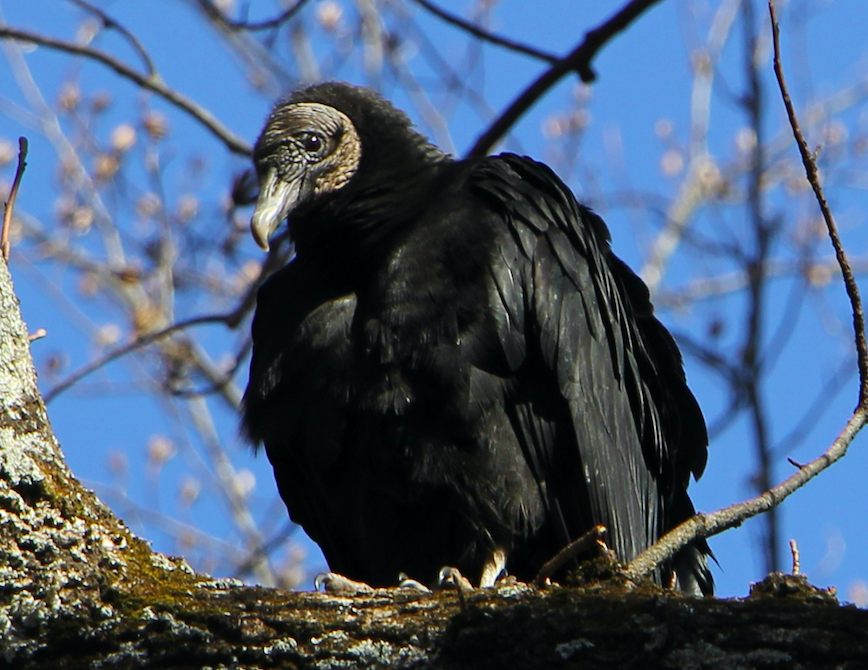
A species subject to many myths and misidentification, the first bird for our #sciencesaturday spring spotlight is the American black vulture (Coragyps atratus). With glossy black plumage, a naked gray-black head, short tail and talons, the black vulture is one of our resident scavengers. An important link in the food chain by eating and disposing of carrion, vultures provide an ecological service by reducing disease breeding grounds. The adaptation of having a feather-free face is very hygienic for a bird that spends the majority of feeding time sticking their noggins into dead species. This way the rotting flesh does not stick to their face.
Vultures have an excellent immune system, eating carcasses without contracting typical diseases like anthrax, cholera, or salmonella. While they have very sharp beaks to tear through thick hides, vultures are not usually able to attack live prey. Their feet and talons are more similar to a chicken than the sharp claws of a hawk or other raptor. Thus, it is very unlikely they are able to take down a struggling animal, such as claims that state they kill livestock. Although not listed as threatened or endangered, in urban areas, they are labeled as a nuisance or pest species. With easy access to garbage dumps and a decrease in sensitivity towards people, black vultures congregate in large groups around discarded food.
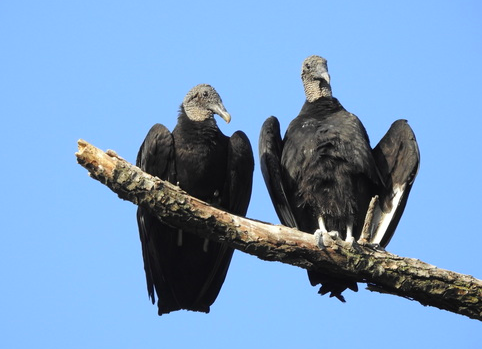
Found in many varieties of environments across the States, black vultures have several adaptations to help them regulate their temperatures. They often spend early mornings sunbathing with their wings spread to raise their body temperature waiting for morning thermal air currents to form. If they need to cool down, they will excrete on their legs. In this process of urohidrosis (Greek meaning: “ouron” = urine; “hidrōs” = sweat), the evaporating water from the urine and feces are a mechanism for thermoregulation. This is also seen in other avian species like storks and is similar to sweating for mammals.
There are different names for black vultures depending on where a group of them gather. If flying, they create a kettle. When perched in a tree, they can be called a committee, a venue or even a volt. And if congregated feeding on the ground, they are referred to as a wake. Black vultures are not the only vulture species present at the Preserve and can often be confused with turkey vultures (Cathartes aura). Are you already familiar with ways to tell them apart? Read on to learn more out the similarities and differences between these two species.
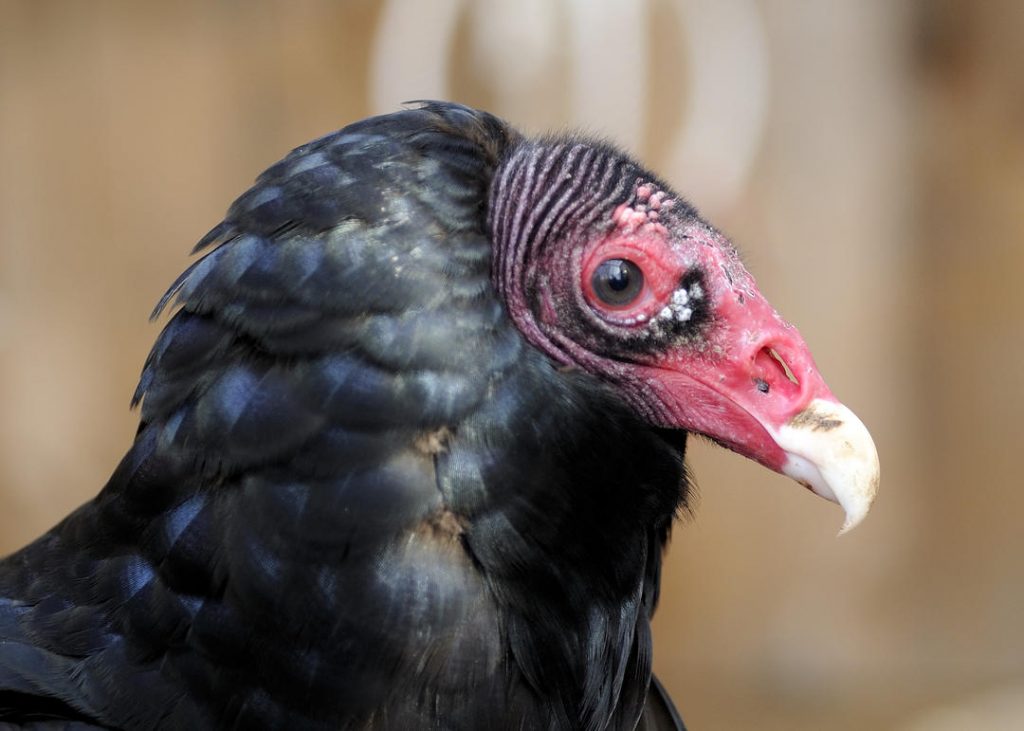
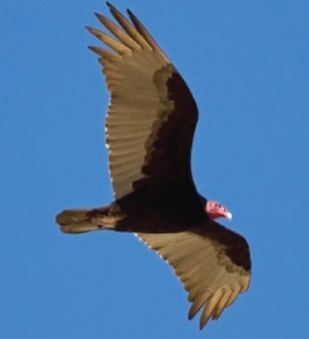
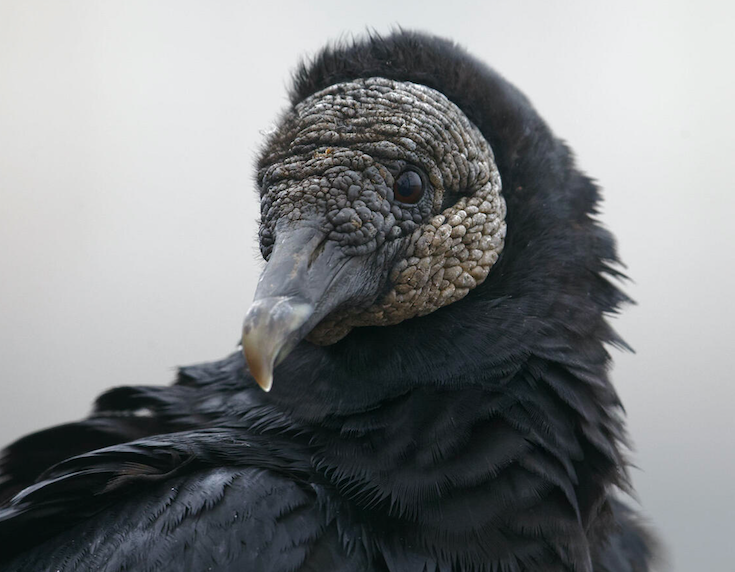
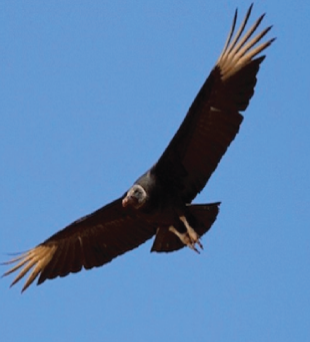
Turkey Vulture vs Black Vulture
- Adult turkey vultures (left images) have a red fleshy head, black/brown body, and a short, sharply hooked, ivory beak
- With the largest olfactory system of all birds, and larger nostrils, they rely on a keen sense of smell to find meals up to a mile away and 12-24 hours old
- Lighter colored feathers that stretch from their “armpits” along their body down to their feather tips
- Lanky birds that make wobbly circles in a teetering flight, fly at lower altitude with wings in a V-shape
- Often roost in large groups, but venture out independently to forage for food; territorial feeders
- The oldest wild turkey vulture was 16 years, 10 months old
- Mature black vultures (right images) have a dark gray head, black body, and a darker beak
- Due to their poor sense of smell, they will actually shadow turkey vultures and follow them to food sources
- Only has the lighter coloration underneath on the tips of their wings
- Compact birds with broad wings, short tails, they have strong wingbeats followed by short glides, they soar high in the sky on thermals
- Lacks a voice box limiting vocal abilities to hisses and grunts
- Highly social birds that can outcompete turkey vultures in larger flocks for food source, and will even share food with relatives
- The oldest wild black vulture was 25 years, 6 months old
Black Vulture Presence at the Preserve
The standing old house on the eastern side of the Green Trail (Fern Hollow Loop) is more than a cultural heritage site. It is now a seasonal home to a pair of black vultures, who return each spring to raise their young within the structure. Black vultures do not build nests, but instead will use cliff faces, stumps, caves, and protected areas on the ground. One to three eggs are incubated by both parents for 37 to 41 days.
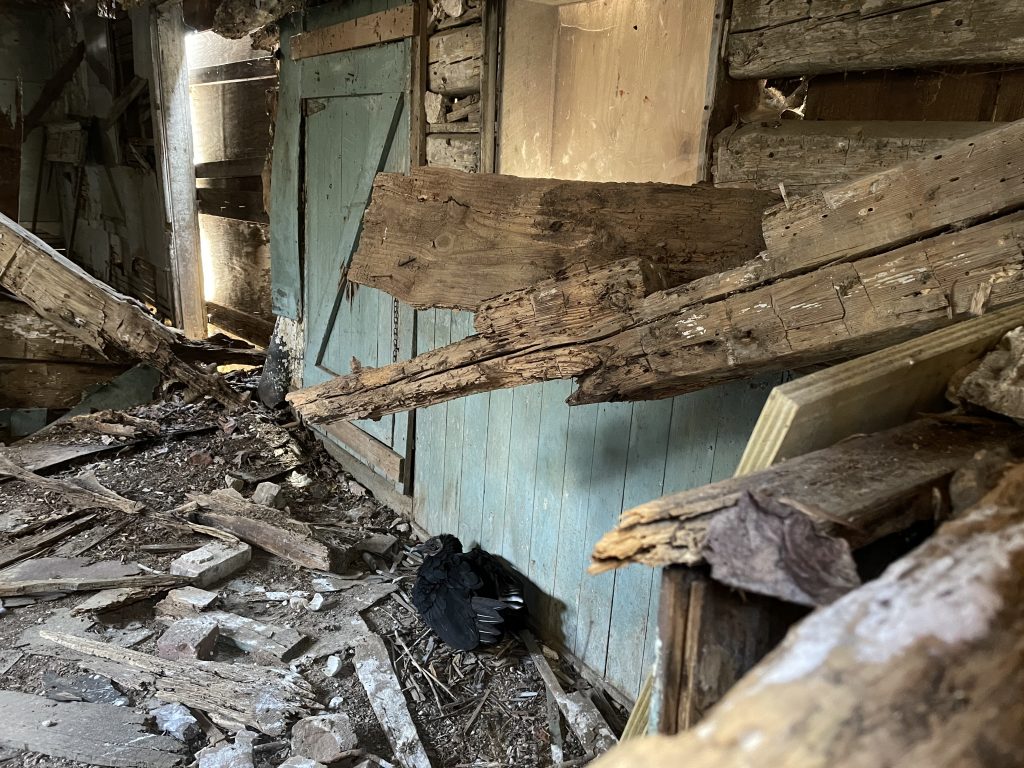
Once they hatch the young are fed from regurgitation (which is also a defense mechanism, where vultures will vomit when threatened!), even months after they have fledged. The juveniles are able to fly 75 to 80 days after hatching.
Yesterday on the Preserve Grand Prix Hike, participants were rewarded for braving the cold by Mother Nature when we looked inside the house through a crack in the wall: one of the resident black vultures was sitting on the ground in the same spot as the picture above from last year! Although we did not specifically see any eggs, we can infer that the pair are now incubating and the scavenger’s Airbnb home will be otherwise occupied for the foreseeable future. Please be mindful not to disturb protective parents if looking for them or their chicks later this spring.
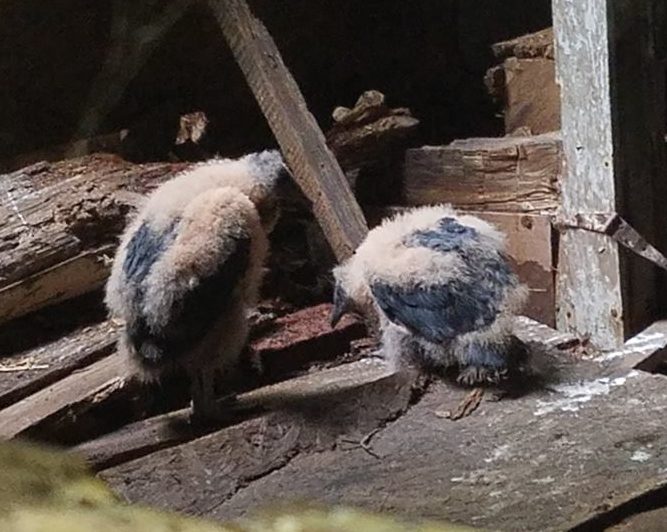
Lastly, be careful when referring to vultures as “buzzards”. It is a colloquial accepted term in North America, but if you are visiting Europe or parts of Asia, the word “buzzard” actually refers to hawks and eagles (birds with feathery heads and a poor sense of smell). Those international buzzards are assigned to the family Accipitridae. The vultures and condors in the States are bald with a better sense of smell, and they belong to the family Cathartidae.
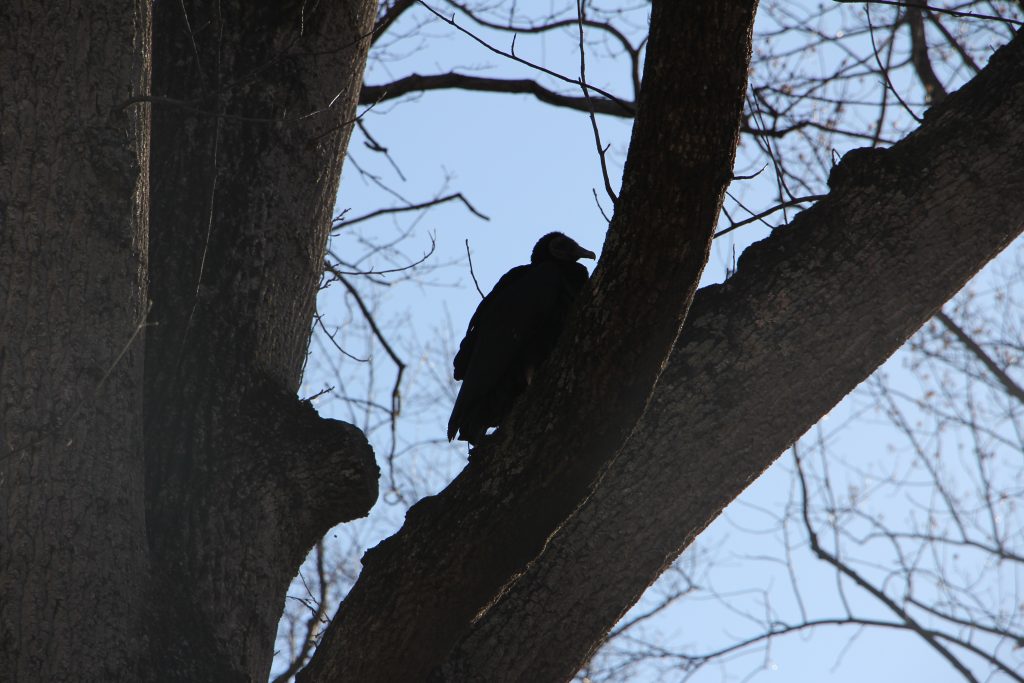
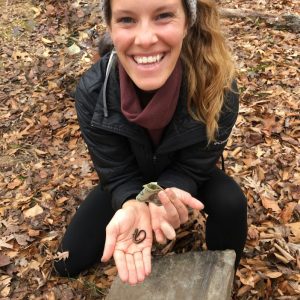
My friend lost a foal to a group of these when it was born
My resident black vultures don’t attack my cats or dog, but eat ten dollars of beef and pork from the store. It’s been going on for five years.
I feed the black vultures every morning. I live near a park in the center of Mclean, Va. and have lots of trees on the property. Next-door is an office building. They have filed a complaint with the police about my feeding the birds and say they might have damaged their roof and poop on peoples’ parked cars. They do no harm and I’m really upset. Any suggestions?
Hi Jackie!
Taryn here, Preserve Specialist over at Bull Run Mountains Natural Area Preserve 🙂
I totally understand your love of black vultures! I am currently completing my dissertation research on the topic of black vultures and their conflicts with people. They are certainly very important and misunderstood birds. As a fellow vulture fan, I would advise against continuing to feed your residents birds, though. The issue with feeding wildlife of any kind is that if habituates them to human presence and makes them more likely to interact with other humans–who may not be as understanding as you or I. This can inadvertently put the birds in danger of being “culled,” a practice that is not unprecedented in the northern Virginia area. To prevent your neighbors or anyone else from potentially alerting authorities to birds who might be considered “nuisances,” it is best that you discontinue your feeding practice. Instead, just continue allowing them to roost and enjoying their visits!
If you have any further questions or concerns, please reach out to me directly at tarynbk@vof.org
Best,
Taryn
I have a single black vulture that stayed behind when its flock flew off. It stays in a small group of hardwood trees near the pool that we didn’t close this year. He has fluffy hair on his lower leg so maybe a late born? He eats eggs and meat in the early morning. The opossum eats the food if put out at night.
Vultures have just moved into a wooded area next to my house. After reading the article, I can identify both black and turkey vultures. There is some vigorous beating of wings in the trees about 15 feet up, and they are dropping down to the ground. I think the wings beating may be their way of scaring me & my dog (leashed) away. Is it possible that the dropping down to the wooded floor is because of their young falling out of a nest? They have only recently shown up.
When nesting, vultures will typically find a cavity or abandoned structure and care for their chicks in pairs. So, if you have a big group of congregating vultures in trees, they probably aren’t currently nesting–so I wouldn’t worry about any babies falling, unless you see it. If you do, you can attempt to place the baby back into their nesting area, or just let mom and dad care for them there 🙂
My wife actually managed to capture a picture of a turkey vulture next to a black vulture, on the ground, probably walking toward or away from a cadaver (I can’t recall–it was 2015). They seemed to tolerate each other without problems. The turkey vulture has a more hooked beak, so maybe the black vulture waited for the turkey vulture to rip open the carcass.
(Just read the article re: black vulture’s poor sense of smell. How in heck did evolution let _that_ happen?)
I saw 3 black vultures in my yard today. Would they attack my cats or my dog?
Vultures are not birds of prey and generally do not seek out live animals to attack. However, they can attack if they feel threatened or defensive around their nests. As a general rule, do not leave pets outdoors unattended and defenseless. There are other threats to them beyond birds of prey. If you have a problem with vultures or any other raptors in your yard, please contact the Virginia Department of Wildlife Resources or USDA Wildlife Services. These species are protected under the Federal Migratory Bird Treat Act.
Comments are closed.